英语期末翻译
期末英语作文带翻译
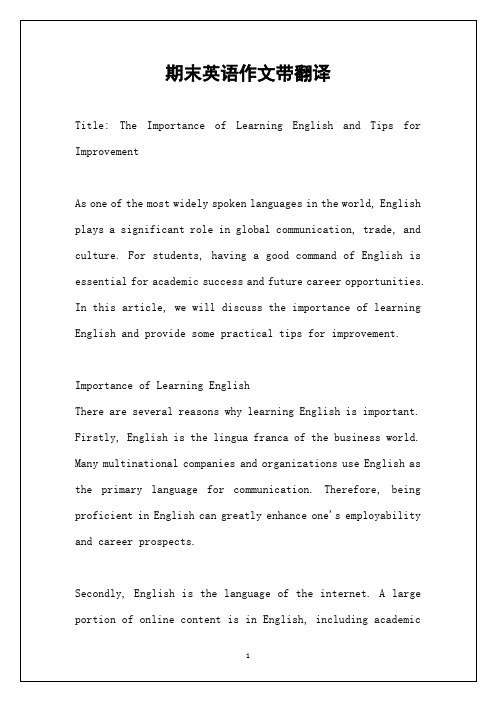
Secondly, English is the language of the internet. A large portion of online content is in English, including academicjournals, news articles, and entertainment. By mastering English, students can access a wealth of information and resources that would otherwise be unavailable to them.
其次,英语是互联网的语言。很大一部分在线内容都是用英语,包括学术期刊、新闻文章和娱乐内容。通过掌握英语,学生可以获取大量信息和资源,否则这些资源将对他们不可见。
此外,英语是科学技术的语言。大多数研究论文和技术创新都是用英语发表的,所以对于希望从事这些领域的学生来说,掌握好英语至关重要。
提高方法
提高英语水平需要投入时间和练习。以下是一些建议帮助学生提高英语能力:
5. Seek feedback: It's important for students to receive feedback on their language skills. They can ask teachers, tutors, or native speakers to provide constructive criticism and guidance for improvement.
英语期末考试翻译
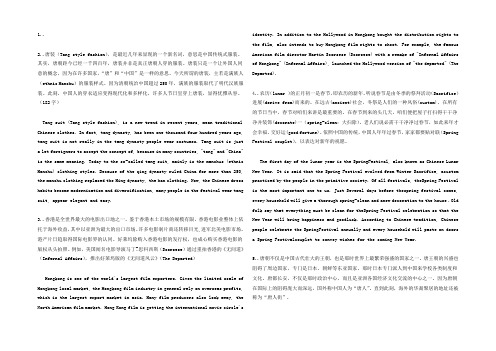
1..2..唐装(Tang style fashion),是最近几年来显现的一个新名词,意思是中国传统式服装。
其实,唐朝距今已经一千四百年,唐装并非是真正唐朝人穿的服装。
唐装只是一个让外国人同意的概念,因为在许多国家,“唐”和“中国”是一样的意思。
今天所谓的唐装,主若是满族人(ethnic Manchu)的服装样式。
因为清朝统治中国超过250年,满族的服装取代了明代汉族服装。
此刻,中国人的穿衣适应变得现代化和多样化,许多人节日里穿上唐装,显得优雅从容。
(182字)Tang suit (Tang style fashion), is a new trend in recent years, mean traditional Chinese clothes. In fact, tang dynasty, has been one thousand four hundred years ago, tang suit is not really in the tang dynasty people wear costumes. Tang suit is just a let foreigners to accept the concept of, because in many countries, "tang" and "China" is the same meaning. Today to the so-called tang suit, mainly is the manchus (ethnic Manchu) clothing styles. Because of the qing dynasty ruled China for more than 250, the manchu clothing replaced the Ming dynasty, the han clothing. Now, the Chinese dress habits become modernization and diversification, many people in the festival wear tang suit, appear elegant and easy.3..香港是全世界最大的电影出口地之一。
大一下期末英语翻译
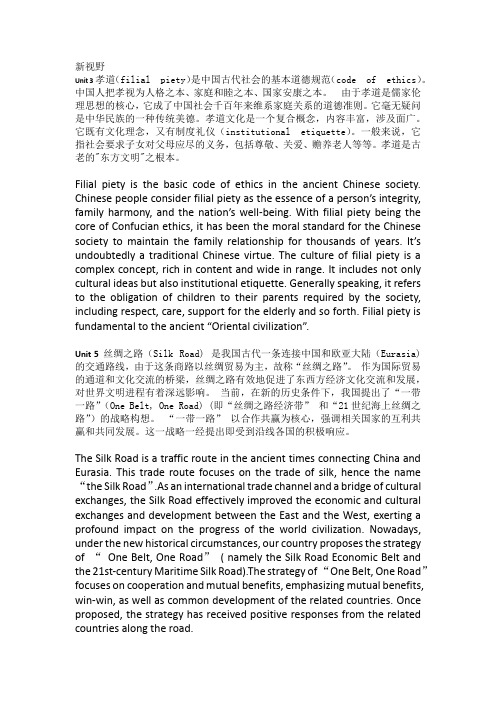
新视野Unit3孝道(filial piety)是中国古代社会的基本道德规范(code of ethics)。
中国人把孝视为人格之本、家庭和睦之本、国家安康之本。
由于孝道是儒家伦理思想的核心,它成了中国社会千百年来维系家庭关系的道德准则。
它毫无疑问是中华民族的一种传统美德。
孝道文化是一个复合概念,内容丰富,涉及面广。
它既有文化理念,又有制度礼仪(institutional etiquette)。
一般来说,它指社会要求子女对父母应尽的义务,包括尊敬、关爱、赡养老人等等。
孝道是古老的"东方文明"之根本。
Filial piety is the basic code of ethics in the ancient Chinese society. Chinese people consider filial piety as the essence of a person’s integrity, family harmony, and the nation’s well-being. With filial piety being the core of Confucian ethics, it has been the moral standard for the Chinese society to maintain the family relationship for thousands of years. It’s undoubtedly a traditional Chinese virtue. The culture of filial piety is a complex concept, rich in content and wide in range. It includes not only cultural ideas but also institutional etiquette. Generally speaking, it refers to the obligation of children to their parents required by the society, including respect, care, support for the elderly and so forth. Filial piety is fundamental to the a ncient “Oriental civilization”.Unit 5 丝绸之路(Silk Road) 是我国古代一条连接中国和欧亚大陆(Eurasia) 的交通路线,由于这条商路以丝绸贸易为主,故称“丝绸之路”。
英语期末总结英文版带翻译

英语期末总结英文版带翻译As the final semester of English comes to a close, I find myself reflecting on all the progress I have made and the lessons I have learned. This semester has been challenging at times, but through hard work and perseverance, I have grown as a student of the English language. Here, I will summarize my experiences and evaluate my own performance.During this semester, we covered various aspects of English such as grammar, vocabulary, reading, writing, and speaking. We delved deep into understanding the fundamental rules of grammar, from sentence structure to verb tenses. Moreover, we expanded our vocabulary through weekly vocabulary quizzes and exercises, helping us to express ourselves more precisely and convey our thoughts effectively.One of the highlights of this semester was our extensive reading program. We were introduced to a range of literary works, including short stories, poems, and novels. The variety of genres allowed us to explore different writing styles and gain a deeper appreciation for literature. Additionally, we engaged in lively discussions and shared our interpretations of the texts, enhancing our critical thinking skills and broadening our perspectives.Writing assignments played a significant role in our progress. Each week, we completed different types of writing tasks, such as essays, journal entries, and creative writing. These assignments helped me develop my writing skills and encouraged me to be more expressive.I learned to structure my ideas logically and present arguments coherently. Feedback from my teacher and peers was also invaluable in identifying areas for improvement and refining my writing.Another aspect of the English class that greatly helped me improve was our speaking activities. We participated in regular class discussions, presentations, and debates. These activities pushed me out of my comfort zone and helped me gain confidence in expressing my opinions in English. Through speaking in front of others, I learned to organize my thoughts quickly and effectively articulate my ideas. Furthermore, the constructive criticism from my classmates and teacher allowed me to identify and correct my pronunciation and grammar mistakes.Throughout the semester, grammar tests were conducted to assess our understanding of the concepts taught. These assessments not only reinforced our knowledge but also helped us identify areas of weakness that needed improvement. I realized that grammar is not just a set of rigid rules, but rather a tool that enhances communication and understanding. With each test, I saw my scores improve, indicating that my efforts to study and practice grammar had paid off.Reflecting on my performance, I am proud of the progress I have made. However, I am also aware that there is room for improvement. Moving forward, I plan to continue working on my vocabulary expansion by reading more books, newspapers, and articles. I also aim towrite regularly to refine my writing style and continue practicing grammar exercises to strengthen my foundation. Additionally, I will make an effort to speak English as much as possible, seeking opportunities for conversations with native speakers or language exchange partners.In conclusion, this semester has been enriching and rewarding. I have enhanced my grammar skills, expanded my vocabulary, improved my reading and writing abilities, and gained confidence in speaking English. I am grateful for the guidance and support of my teacher and classmates throughout this journey. English is no longer just a subject for me, but a lifelong skill that I will continue to cultivate and utilize. I am excited to continue my English language learning journey in the future and see where it takes me!这个学期基本结束,我不禁回顾自己的进步和所学到的知识。
高英2 期末考试英语翻译文章

翻译Lesson 7 The Libido for the UglyParagraph 1On a winter day some years ago, coming out of Pittsburgh on one of the expresses of the Pennsylvania Railroad, I rolled eastward for an hour through the coal and steel towns of Westmoreland country.It was familiar ground; boy and man, I had been through it often before. But somehow I had never quite sensed its appalling desolation.Here was the very heart of industrial Ameria, the center of its most lucrative and characteristic activity, the boast and pride of the richest and grandest nation ever seen on earth---and here was a scene so dreadfully hideous, so intolerably bleak and forlorn that it reduced the whole aspiration of man to a macabre and depressing joke.Here was wealth beyond computation, almost beyond imagination---and here were human habitations so abominable that they would have disgraced a race of alley cats.Paragraph 2I am not speaking of mere filth. One expects steel towns to be dirty. What I allude to is the unbroken and agonizing ugliness, the sheer revolting monstrousness, of every house in sight.From East Liberty to Greensburg, a distance of 25 miles, there was not one in sight from the train that did not insult and lacerate the eye.Some were so bad, and they were among the most pretentious --churches, stores, warehouses, and the like--that they were downright startling; one blinked before them as one blinks before a man with his face shot away.A few linger in memory, horrible even there: a crazy little church just west of Jeannette, set like a dormer window on the side of a bare leprous hill; the headquarters of the Veterans of Foreign Wars at another forlorn town, a steel stadium like a huge rat--trap somewhere further down the line.But most of all I recall the general effect--of hideousness without a break. There was not a single decent house within eyerange from the Pittsburgh to the Greensburg yards.There was not one that was not misshapen, and there was not one that was not shabby.Lesson 6 Disappearing through the SkylightParagraph 13The playfulness of the modern aesthetic is, finally, its most striking---and also its most serious and, by corollary, its most disturbing ---feature.The playfulness imitates the playfulness of science that produces game theory and virtual particles and black holes and that, by introducing human growth genes into cows, forces students of ethics to reexamine the definition of cannibalism.The importance of play in the modern aesthetic should not come as a surprise. It is announced in every city in the developed world by the fantastic and playful buildings of postmodernism and neomodernism and by the fantastic juxtapositions of architectural styles that typify collage city and urban adhocism. Paragraph 14Today modern culture includes the geometries of the International Style, the fantasies of facadism, and the gamesmanship of theme parks and museum villages.It pretends at times to be static but it is really dynamic. Its buildings move and sway and reflect dreamy visions of everything that is going on around them.It surrounds its citizens with the linear sculpture of pipelines and interstate highways and high--tension lines and the delicate virtuosities of the surfaces of the Chrysler Airflow and the Boeing 747 and the lacy weavings of circuits etched on silicon, as well as with the brutal assertiveness of oil tanker and bulldozers and the Tinkertoy complications of trusses and geodesic domes and lunar landers.It abounds in images and sounds and values utterly different from those of the world of natural things seen from a middle distance.Lesson 5 Love Is a FallacyParagrath 145-154I dashed perspiration from my brow. “Polly,” I croaked, “you mustn’t take all these things so literally. I mean this is just classroom stuff. You know that the things you learn in school don’t have anything to do with life.”“Dicto Simpliciter, ” she said, wagging her finer at me playfully.That did it. I leaped to my feet, bellowing like a bull. “Will you or will you not go steady with me?”“I will not,” she replied.“Why not?” I demanded.“Because this afternoon I promised Petey that I would go steady with him.”I reeled back, overcome with the infamy of it. After he promised, after he made a deal, after he shook my hand! “The rat!” I shrieked, kicking up great chunks of turf. “You can’t go with him, Polly. He is a liar. He is a cheat. He is a rat.”“ Poisoning the well,” said Polly, “and stopping shouting. I think shouting must be a fallacy too.”With an immense efforts of will, I modulated my voice. “All right,” I said. “You are a logician. Let us look at this thing logically. How could you choose Petey over me? Look at me--a brilliant student, a tremendous intellectual, a man with an assured future. Look at Petey---a knothead, a jitterbug, a guy who will never know where his next meal is coming from. Can you give me one logical reason why you should go stead with him?”“I certainly can,” declared Polly, “He’s got a raccoon coat.”Lesson 4 Inaugural AddressParagraph 23Can we forge against these enemies a grand and global alliance, North and South, East and West, that can assure a more fruitful life for all mankind? Will you join in the historic effort?Paragraph 24In the long history of the world, only a few generations have been granted the role of defending freedom in its hour of maximum danger. I do not shrink from this responsibility; I welcome it. I do not believe that any of us would exchange places with any other people or any other generation. The energy, the faith, the devotion which we bring to this endeavor will light our country and all who serve it, and the glow from that fire can truly light the world.Paragraph 25And so, my fellow Americans ask not what your country can do for you, but what you can do for your country.Paragraph 26My fellow citizens of the world, ask not what America will do for you, but what together we can do for the freedom of man.Lessen 3 Pub Talk and the King’s EnglishParagraph 9Someone took one of the best-known of examples, which is still always worth the reconsidering. When we talk of meat on our tables we use French words; when we speak of the animals from which the meat comes we use Anglo-Saxon words. It is a pig in its sty; it is pork (porc) on the table. They are cattle in the fields, but we sit down to beef (boeuf). Chickens become poultry (poulet), and a calf becomes veal (veau). Even if our menus were not written in French out of snobbery, the English we used in them would still be Norman English. What all this tells us is of a deep class rift in the culture of England after the Norman conquest.Paragraph 10The Saxon peasants who tilled the land and reared the animals could not afford the meat, which went to Norman tables. The peasants were allowed to eat the rabbits that scampered over their fields and, since that meat was cheap, the Norman lords of course turned up their up noses at it. So rabbit is still rabbit on our tables, and not changed into some rendering of lapin.Paragraph 11As we listen today to the arguments about bilingual education, we ought to think ourselves back intothe shoes of the Saxon peasant. The new ruling class had built a cultural barrier against him by building their French against his own language. There must have been a great deal oaf cultural humiliation felt by the English when they revolted under Saxon leaders like Hereward the Wake. “The King’s English”--if the term had existed then--had become French. And here in America now, 900 years later, we are still the heirs to it.Lessen 2 MarrakechParagraph20But what is strange about these people is their invisibility. For several weeks, always at about the same time of day, the file of old women had hobbled past the house with their firewood, and though they had registered themselves on my eyeballs I cannot truly say that I had seen them. Firewood was passing--that was how I saw it. It was only that one day I happened to be walking behind them, and the curious up-and-down motion of a load of wood drew my attention to the human being beneath it. Then for the first time I noticed the poor old earth--coloured bodies, bodies reduced to bones and leathery skin, bent double under the crushing weight. Yet I suppose I had not been five minutes on Moroccan soil before I noticed the overloading of the donkeys and was infuriated by it. There is no question that the donkeys are damnably treated. The Moroccan donkey is hardly bigger than a St.Bernard dog, it carries a load which in the British Army would be considered too much for a 15-hands mule, and very often its packsaddle is not taken off its back for weeks together. But what is peculiarly pitiful is that it is the most willing creature on earth, it follows its master like a dog and does not need either bridle or halter. After a dozen years of devoted work it suddenly drops dead, whereupon its master tips it into the ditch and the village dogs have torn its guts out before it is cold.Paragraph 21This kind of thing makes one’s blood boil, whereas--on the whole--the plight of the human beings does not. I am not commenting, merely pointing to a fact. People with brown skins are next door to invisible. Anyone can be sorry for the donkey with its galled back, but it is generally owing to some kind of accident if one even notices the old woman under her load of sticks.Lesson 1 Face to Face with Hurricane CamilleParagraph 21Seconds after the roof blew off the Koshak house, John yelled, “Up the stairs--into our bedroom! Count the kids.”The children huddled in the slashing rain within the circle of adults. Grandmother Koshak implored, “Children, let’s sing!”The children were too frightened to respond. She carried on alone for a few bars; then her voice trailed away.Paragraph 22Debris flew as the living-room fireplace and its chimney collapsed. With two walls in their bedroom sanctuary beginning to disintegrate, John ordered, “Into the television room!” This was the room farthest from the direction of the storm.Paragraph 23For an instant, John put his arm around his wife, Janis understood. Shivering from the wind and rain and fear, clutching 2 children to her, she thought. Dear Lord, give me the strength to endure what I have to. She felt anger against the hurricane. We won’t let it win.Paragraph 24Pop Koshak raged silently, frustrated at not being able to do anything to fight Camaille. Without reason, he dragged a cedar chest and a double mattress from a bedroom into the TV room. At that moment, the wind tore out one wall and extinguished the lantern. A second wall moved, waved, Charlie Hill tried to support it, but it toppled on him, injuring his back. The house, shuddering and rocking, had moved 25 feet from its foundations. The world seemed to be breaking apart.Paragraph 25“let’s get that mattress up!” John shouted to his father. “Make it a lean-to against the wind. Get the kids under it. We can prop it up with our heads and shoulders!”Paragraph 26The larger children sprawled on the floor, with the smaller ones in a layer on top of them, and the adults bent over all nine. The floor tilted. The box containing the litter of kittens slid off a shelf and vanished in the wind. Spooky flew off the top of a sliding bookcase and also disappeared. The dog cowered with eyes closed. A third wall gave way. Water lapped across the slanting floor. John grabbed a door which was still hinged to one closet wall. “If the floor goes,” he yelled at his father, “ Let’s go the kids on this.”Paragraph 27In that moment, the wind slightly diminished, and the water stopped rising. Then the water began receding. The main thrust of Camille had passed. The Koshaks and their friends had survived.。
大学英语期末考试翻译考试重点
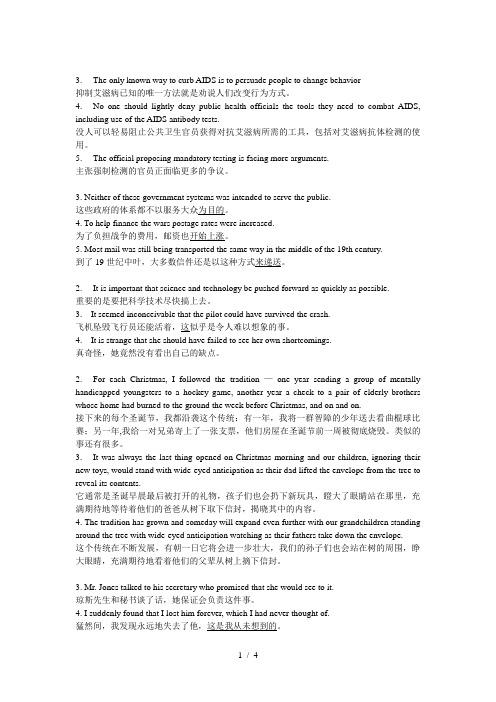
3. The only known way to curb AIDS is to persuade people to change behavior抑制艾滋病已知的唯一方法就是劝说人们改变行为方式。
4. No one should lightly deny public health officials the tools they need to combat AIDS, including use of the AIDS antibody tests.没人可以轻易阻止公共卫生官员获得对抗艾滋病所需的工具,包括对艾滋病抗体检测的使用。
5. The official proposing mandatory testing is facing more arguments.主张强制检测的官员正面临更多的争议。
3. Neither of these government systems was intended to serve the public.这些政府的体系都不以服务大众为目的。
4. To help finance the wars postage rates were increased.为了负担战争的费用,邮资也开始上涨。
5. Most mail was still being transported the same way in the middle of the 19th century.到了19世纪中叶,大多数信件还是以这种方式来递送。
2. It is important that science and technology be pushed forward as quickly as possible.重要的是要把科学技术尽快搞上去。
3. It seemed inconceivable that the pilot could have survived the crash.飞机坠毁飞行员还能活着,这似乎是令人难以想象的事。
南昌大学学术英语期末考试课文翻译
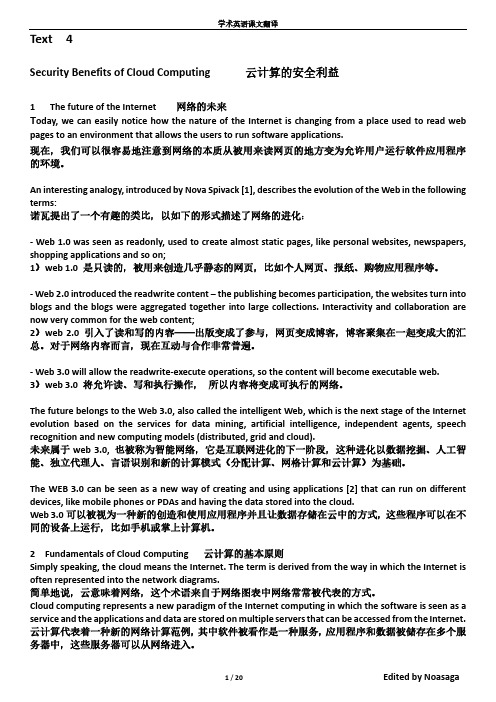
Text 4Security Benefits of Cloud Computing 云计算的安全利益1The future of the Internet 网络的未来T oday, we can easily notice how the nature of the Internet is changing from a place used to read web pages to an environment that allows the users to run software applications.现在,我们可以很容易地注意到网络的本质从被用来读网页的地方变为允许用户运行软件应用程序的环境。
An interesting analogy, introduced by Nova Spivack [1], describes the evolution of the Web in the following terms:诺瓦提出了一个有趣的类比,以如下的形式描述了网络的进化:- Web 1.0 was seen as readonly, used to create almost static pages, like personal websites, newspapers, shopping applications and so on;1)web 1.0 是只读的,被用来创造几乎静态的网页,比如个人网页、报纸、购物应用程序等。
- Web 2.0 introduced the readwrite content – the publishing becomes participation, the websites turn into blogs and the blogs were aggregated together into large collections. Interactivity and collaboration are now very common for the web content;2)web 2.0 引入了读和写的内容——出版变成了参与,网页变成博客,博客聚集在一起变成大的汇总。
高级英语1期末paraphrase及翻译

如何将所学应用于实际工作与生活
主动倾听
在实际沟通中,要积极倾听他人的观点和需 求,理解对方的意图和情感。
清晰表达
将自己的想法和意见用简洁明了的语言表达 出来,避免模糊和歧义。
非语言沟通
注意自己的非语言信号,如表情、肢体语言 等,确保信息的一致性和完整性。
适应不同沟通风格
根据不同的沟通环境和对象,灵活运用不同 的沟通技巧,以实现更好的沟通效果。
2023-12-27
有效沟通技巧培训ppt课件
汇报人:可编辑
目 录
• 有效沟通概述 • 有效沟通技巧 • 沟通风格与策略 • 跨文化沟通 • 团队沟通 • 总结与展望
01
有效沟通概述
沟通的定义与重要性
沟通的定义
沟通是一个过程,通过语言、文 字或非语言的方式,传递和接收 信息、情感和思想。
沟通的重要性
06
总结与展望
有效沟通技巧培训的意义与影响
1 2
提升个人和团队沟通能力
通过培训,个人和团队成员能够掌握有效的沟通 技巧,提高沟通效率和效果,减少误解和冲突。
增强团队协作与凝聚力
良好的沟通有助于团队成员更好地协作,形成更 紧密的合作关系,增强团队的凝聚力和战斗力。
3
促进组织发展和目标实现
有效的沟通有助于组织内部信息的顺畅传递,提 高决策效率和执行力,推动组织目标的实现。
语气和语调的变化可以影 响表达的情感和意义,因 此要掌握好语气和语调的 运用。
非语言沟通技巧
肢体语言 肢体语言可以传递出很多信息, 例如姿势、动作和面部表情等。 要注意自己的肢体语言,保持良
好的姿态和表情。
眼神交流
通过眼神交流,可以传递出信任、 支持和友好等情感。要注意与对方 保持眼神交流,以增强沟通效果。
(完整版)期末英语翻译
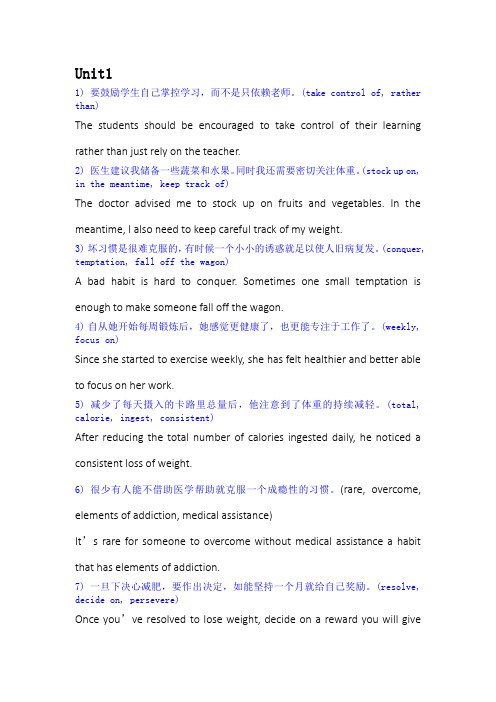
Unit11) 要鼓励学生自己掌控学习,而不是只依赖老师。
(take control of, rather than)The students should be encouraged to take control of their learning rather than just rely on the teacher.2) 医生建议我储备一些蔬菜和水果。
同时我还需要密切关注体重。
(stock up on, in the meantime, keep track of)The doctor advised me to stock up on fruits and vegetables. In the meantime, I also need to keep careful track of my weight.3)坏习惯是很难克服的,有时候一个小小的诱惑就足以使人旧病复发。
(conquer, temptation, fall off the wagon)A bad habit is hard to conquer. Sometimes one small temptation is enough to make someone fall off the wagon.4)自从她开始每周锻炼后,她感觉更健康了,也更能专注于工作了。
(weekly, focus on)Since she started to exercise weekly, she has felt healthier and better able to focus on her work.5) 减少了每天摄入的卡路里总量后,他注意到了体重的持续减轻。
(total, calorie, ingest, consistent)After reducing the total number of calories ingested daily, he noticed a consistent loss of weight.6) 很少有人能不借助医学帮助就克服一个成瘾性的习惯。
英语期末翻译
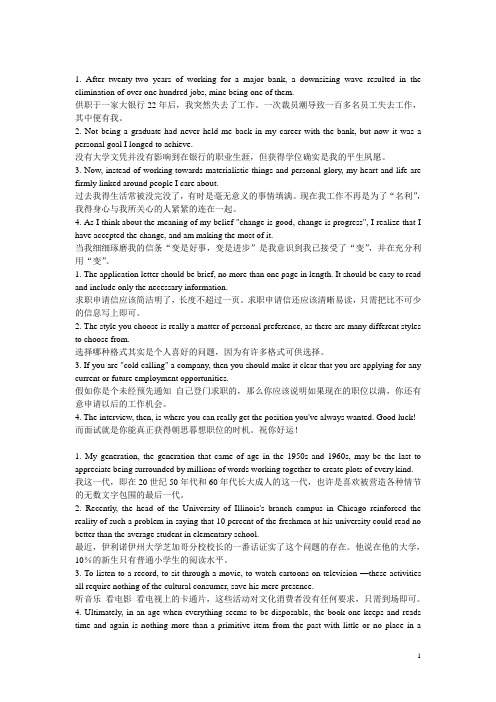
1. After twenty-two years of working for a major bank, a downsizing wave resulted in the elimination of over one hundred jobs, mine being one of them.供职于一家大银行22年后,我突然失去了工作。
一次裁员潮导致一百多名员工失去工作,其中便有我。
2. Not being a graduate had never held me back in my career with the bank, but now it was a personal goal I longed to achieve.没有大学文凭并没有影响到在银行的职业生涯,但获得学位确实是我的平生夙愿。
3. Now, instead of working towards materialistic things and personal glory, my heart and life are firmly linked around people I care about.过去我得生活常被没完没了,有时是毫无意义的事情填满。
现在我工作不再是为了“名利”,我得身心与我所关心的人紧紧的连在一起。
4. As I think about the meaning of my belief "change is good, change is progress", I realize that I have accepted the change, and am making the most of it.当我细细琢磨我的信条“变是好事,变是进步”是我意识到我已接受了“变”,并在充分利用“变”。
1. The application letter should be brief, no more than one page in length. It should be easy to read and include only the necessary information.求职申请信应该简洁明了,长度不超过一页。
高级英语期末paraphrase及翻译
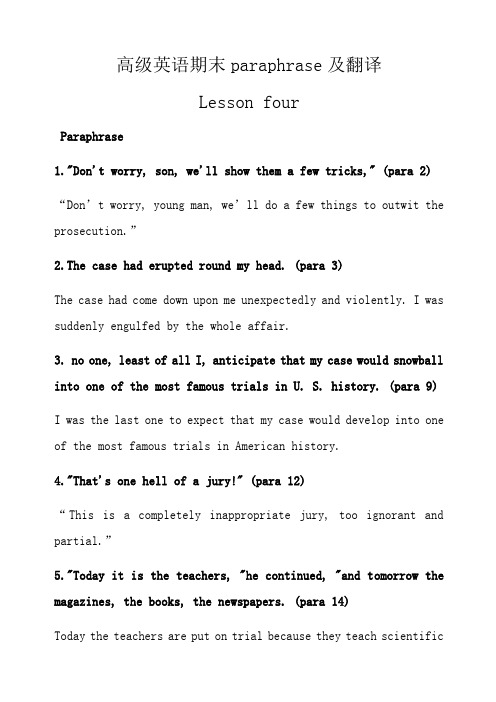
高级英语期末paraphrase及翻译Lesson fourParaphrase1."Don't worry, son, we'll show them a few tricks," (para 2)“Don’t worry, young man, we’ll do a few things to outwit the prosecution.”2.The case had erupted round my head. (para 3)The case had come down upon me unexpectedly and violently. I was suddenly engulfed by the whole affair.3. no one, least of all I, anticipate that my case would snowball into one of the most famous trials in U. S. history. (para 9) I was the last one to expect that my case would develop into one of the most famous trials in American history.4."That's one hell of a jury!" (para 12)“This is a completely inappropriate jury, too ignorant and partial.”5."Today it is the teachers, "he continued, "and tomorrow the magazines, the books, the newspapers. (para 14)Today the teachers are put on trial because they teach scientifictheory; soon the newspapers and magazines will not be allowed to express new ideas, to spread knowledge of science.6. "There is some doubt about that," Darrow snorted. (para 19) “It is doubtful whether man has reasoning power”, said Darrow sarcastically, scornfully.7. …accused Bryan of calling for a duel to the death between science and religion. (para 23)…accused Bryan of demanding that a life or death struggle be fought between science and region.8. Spectators paid to gaze at it and ponder whether they mightbe related. (para 26)People had to pay in order to have a look at the ape and to consider carefully whether apes and humans could have a common ancestry.9. Now Darrow sprang his trump card by calling Bryan as a witnessfor the defense. (para 30)Darrow surprised everyone by asking for Bryan as a witness for Scopes which was a brilliant idea.10.My heart went out to the old warrior as spectator s pushed by him to shake Darrow's hand.Darrow had gotten the best of Bryan, who looked helplessly lost and pitiable as everyone ignored him and rushed past him to congratulate Darrow. When I saw this, I felt sorry for Bryan. Translation1 我没有预料到会卷入这场争端。
期末统考材料之一:英语翻译50题

1、她的照片出现在当地报纸的头版。
(on the front page)Her picture appeared on the front page of a local newspaper.2、考虑到我们付的价钱,这顿饭很令人失望。
(considering)Considering the price we paid, it was a very disappointing meal.3、我还记得第一次见到他的那一刻。
(the moment when)I remember the moment when I first met him.4、面试进行顺利,尽管还有其他3个候选人,工作还是给了她。
(despite the fact that)The interview had gone well and, despite the fact that there had been three other candidates, the job was hers.5、好多方面你都跟你爸爸很接近。
(in many ways)You're very close to your daddy in many ways.6、我过去常常打高尔夫球,但后来为了得到更多的锻炼改打网球了。
(switch to)I used to play golf but I switched to tennis to get more exercise.7、目前几家大医院都在裁员。
(cut back on)Several mayor hospitals are cutting back on staff at the moment.8、说来也怪,就在昨天还有人问过同样的问题。
(oddly enough)Oddly enough, someone asked me the same question only yesterday.9、她将所有剩下的精力都用到这项任务上。
英语期末总结英语翻译
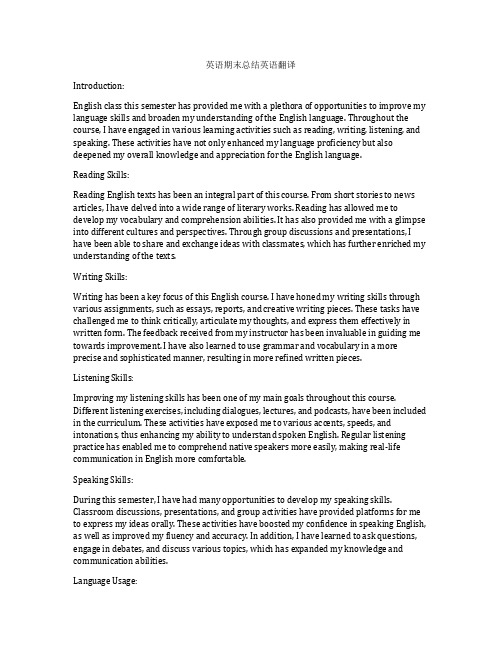
英语期末总结英语翻译Introduction:English class this semester has provided me with a plethora of opportunities to improve my language skills and broaden my understanding of the English language. Throughout the course, I have engaged in various learning activities such as reading, writing, listening, and speaking. These activities have not only enhanced my language proficiency but also deepened my overall knowledge and appreciation for the English language.Reading Skills:Reading English texts has been an integral part of this course. From short stories to news articles, I have delved into a wide range of literary works. Reading has allowed me to develop my vocabulary and comprehension abilities. It has also provided me with a glimpse into different cultures and perspectives. Through group discussions and presentations, I have been able to share and exchange ideas with classmates, which has further enriched my understanding of the texts.Writing Skills:Writing has been a key focus of this English course. I have honed my writing skills through various assignments, such as essays, reports, and creative writing pieces. These tasks have challenged me to think critically, articulate my thoughts, and express them effectively in written form. The feedback received from my instructor has been invaluable in guiding me towards improvement. I have also learned to use grammar and vocabulary in a more precise and sophisticated manner, resulting in more refined written pieces.Listening Skills:Improving my listening skills has been one of my main goals throughout this course. Different listening exercises, including dialogues, lectures, and podcasts, have been included in the curriculum. These activities have exposed me to various accents, speeds, and intonations, thus enhancing my ability to understand spoken English. Regular listening practice has enabled me to comprehend native speakers more easily, making real-life communication in English more comfortable.Speaking Skills:During this semester, I have had many opportunities to develop my speaking skills. Classroom discussions, presentations, and group activities have provided platforms for me to express my ideas orally. These activities have boosted my confidence in speaking English, as well as improved my fluency and accuracy. In addition, I have learned to ask questions, engage in debates, and discuss various topics, which has expanded my knowledge and communication abilities.Language Usage:Throughout this English course, I have learned to improve my overall language usage. This includes understanding and applying grammar rules correctly, expanding my vocabulary, and using idiomatic expressions appropriately. I have also gained a deeper understanding of word usage, connotations, and register, enabling me to communicate more effectively and appropriately in different situations.Cultural Understanding:Learning English is not just about language; it encompasses understanding different cultures as well. Through the texts, discussions, and presentations, I have explored various cultural aspects of English-speaking countries. This has broadened my horizons and allowed me to appreciate the diversity and richness of English-speaking cultures. Understanding cultural differences has also made me more aware of the importance of cultural sensitivity and effective communication in a globalized world.Conclusion:English class this semester has been a comprehensive journey of language learning and personal growth. Through reading, writing, listening, and speaking activities, I have improved my language skills, expanded my knowledge, and gained a deeper appreciation for the English language. This course has not only enhanced my academic performance but also equipped me with valuable skills for real-life communication. I am grateful for the opportunities provided and will continue to strive for further improvement in my English language proficiency.。
(完整版)大学英语4期末考试翻译
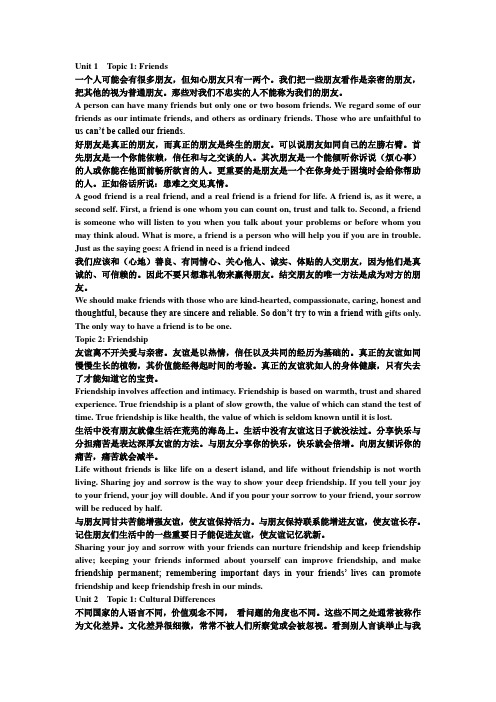
Unit 1 Topic 1: Friends一个人可能会有很多朋友,但知心朋友只有一两个。
我们把一些朋友看作是亲密的朋友,把其他的视为普通朋友。
那些对我们不忠实的人不能称为我们的朋友。
A person can have many friends but only one or two bosom friends. We regard some of our friends as our intimate friends, and others as ordinary friends. Those who are unfaithful to us can’t be called our friends.好朋友是真正的朋友,而真正的朋友是终生的朋友。
可以说朋友如同自己的左膀右臂。
首先朋友是一个你能依赖,信任和与之交谈的人。
其次朋友是一个能倾听你诉说(烦心事)的人或你能在他面前畅所欲言的人。
更重要的是朋友是一个在你身处于困境时会给你帮助的人。
正如俗话所说:患难之交见真情。
A good friend is a real friend, and a real friend is a friend for life. A friend is, as it were, a second self. First, a friend is one whom you can count on, trust and talk to. Second, a friend is someone who will listen to you when you talk about your problems or before whom you may think aloud. What is more, a friend is a person who will help you if you are in trouble. Just as the saying goes: A friend in need is a friend indeed我们应该和(心地)善良、有同情心、关心他人、诚实、体贴的人交朋友,因为他们是真诚的、可信赖的。
大二上大学英语期末考试翻译题答案

GRAMMAR REVIEW1.I’ll borrow whichever tent you are not using now (你们现在不用的任何一顶帐篷).2.Free movie tickets will be given to whoever comes/come first (最早来的人们).3.We agreed to accept whichever/whatever condition our captain thought was the best (任何我们队长认为最佳的条件).4.Friends are forever comforts.Wherever/No matter where I go (无论我走到哪里)their care follows.5.It is neither possible nor sensible for parents to satisfy whatever wishes their child/children expresses/express (孩子表达的任何愿望).6.However disappointed/No matter how disappointed you may feel about the surroundings/environment/situation (不管你对环境有多么失望),you’re supposed to complain less and work more.7.Respect for the law is the foundation of a civilized society. Whoever breaks it (不管谁触犯法律)will be punished.8.David is in the habit of knitting his brows whenever he concentrates on a problem (每当他集中精力思考问题的时候).1.It is not luck but hard work that led him to today’s success.2.Prof.Moen argues that it is energy makes the world go round.3.It is not until he had proved he was honest that he won the family’s trust.4.It was clearly the headmaster himself who/that opened the door for me.5.What is it that Jack has to take into consideration when applying for the job? TRANSLATION1.以共同兴趣为基础的友谊是不容易破裂的.The friendship grounded on common / shared interest does not break up easily. / It is not easy for the friendship grounded on common / shared interest to break up.2.孩子们必须学会将电脑游戏中的暴力和勇敢区分开来.Children must learn to distinguish between violence and bravery / courage in computer games.3.当今世界每天涌现如此多新鲜事物,要求一个人什么都知晓是不合情理的.There spring uo so many new things every day in the world that it is no longer sensible to expect a person to know / keep track of everything.4.诸如背弃朋友这类事并不受法律制约,所以才有了我们称作的“道德法庭”.Laws do not regulate such things as betrayal to friends,that is why there is what we call / is called “the court of morally”.5.有人把今天的文化描述为“快餐文化”.无论做什么事,人们只是追求用最短的时间达到最大的满足.Today’s culture is described as“fast-food culture”.Whatever they may be / are doing,people just pursue the greatest / maximum satisfaction within the shortest time. 6.常言说,天下没有免费的午餐.如果你想要什么,就得去挣.As the saying goes,there is no such thing as a free lunch.If you want something,go and earn / work for it.GRAMMAR REVIEW1.Sitting on the stairs was/On the stairs was sitting (楼梯上坐着)a dark-haired girl.2.Over the wall came/flew (墙那边飞过来了)a shower of stones.3.Round the corner was (拐角那儿)a policeman on the beat.4.Then finally came (终于到了)the graduation ceremony we had been looking forward to.5.Under the table was lying (桌子底下躺着)a half-conscious young man.6.At/On the top of(On top of)the hill stood (山顶矗立着)the castle in all its grace.1.The beaver chews down trees to get food and material to build its home with.2.Do your parents think Tom is a nice boy to go out with?3.The goals for which he has fought all his life seem unimportant to him now.4.A great book,rich in ideas and beauty,demands the most active reading you are capable of.5.The essay starts by asking a question,to which the author then gives a positive answer. TRANSLATION1.无论是友情还是爱情,你都不可能期待自己付出最少而得到最多.In either friendship or love / In both friendship and love,you should never expect to take / receive the maximum while you give the minimum.2.我把全部希望寄托在他的承诺上,结果却发现他根本不是个真诚的人.I built all my hopes on his promise(s),only to find that he was not a man of sincerity at all.3.我们带母亲去了所有我们能找到的最好的医院,但一切努力都是徒劳的,母亲还是没能熬过那次疾病.We took Mother to all the best hospitals we could find,but all our efforts were in vain;she failed to survive the disease.4.情人节是个一年一度在2月14日庆祝的节日,一个向自己心仪的对象表达爱意的好日子. Valentine’s Day is an annual holiday celebrated on February 14,a perfect day to express love to the object of your / one’s affection.5.在信息时代,通过电子邮件方式跟远方的朋友交流几乎可以是同步的.In the information era,communications with far-away friends via e-mail can be almost / virtually simultaneous.6.爱情需要时间,因为只有慢慢习惯和学会欣赏对方才会产生出爱情.Love takes time,for it is not / forged until you have grown used to the other’s company and learned to appreciate the other.。
研究生英语期末考试翻译总结
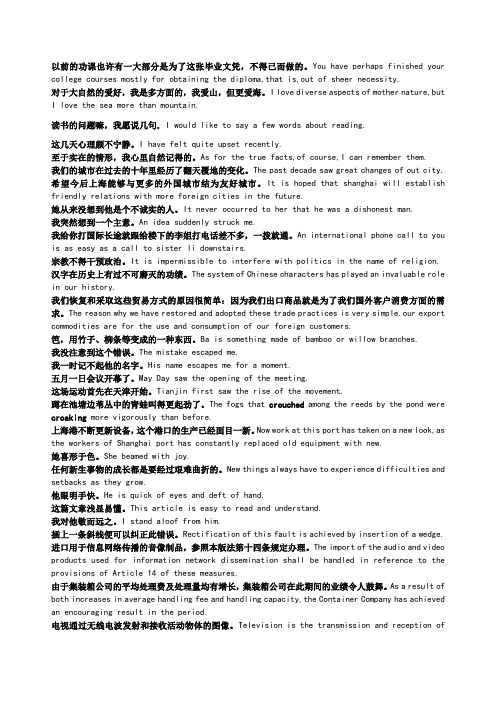
以前的功课也许有一大部分是为了这张毕业文凭,不得已而做的。
You have perhaps finished your college courses mostly for obtaining the diploma,that is,out of sheer necessity.对于大自然的爱好,我是多方面的,我爱山,但更爱海。
I love diverse aspects of mother nature,but I love the sea more than mountain.读书的问题嘛,我愿说几句。
I would like to say a few words about reading.这几天心理颇不宁静。
I have felt quite upset recently.至于实在的情形,我心里自然记得的。
As for the true facts,of course,I can remember them.我们的城市在过去的十年里经历了翻天覆地的变化。
The past decade saw great changes of out city. 希望今后上海能够与更多的外国城市结为友好城市。
It is hoped that shanghai will establish friendly relations with more foreign cities in the future.她从来没想到他是个不诚实的人。
It never occurred to her that he was a dishonest man.我突然想到一个主意。
An idea suddenly struck me.我给你打国际长途就跟给楼下的李姐打电话差不多,一拨就通。
An international phone call to you is as easy as a call to sister li downstairs.宗教不得干预政治。
英语期末考试翻译
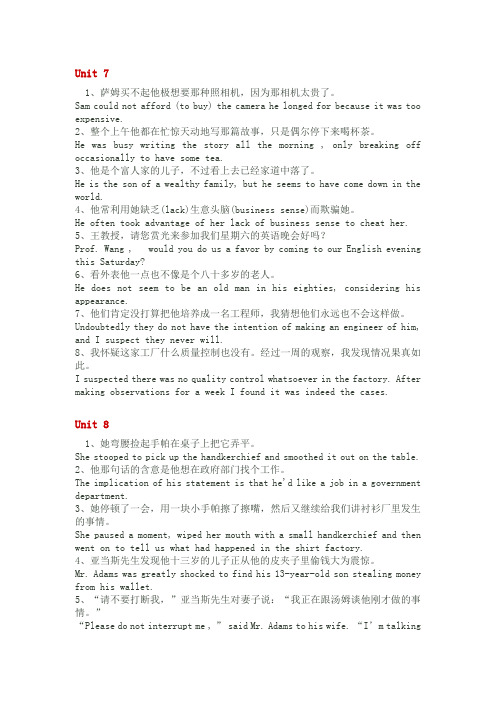
Unit 71、萨姆买不起他极想要那种照相机,因为那相机太贵了。
Sam could not afford (to buy) the camera he longed for because it was too expensive.2、整个上午他都在忙惊天动地写那篇故事,只是偶尔停下来喝杯茶。
He was busy writing the story all the morning , only breaking off occasionally to have some tea.3、他是个富人家的儿子,不过看上去已经家道中落了。
He is the son of a wealthy family, but he seems to have come down in the world.4、他常利用她缺乏(lack)生意头脑(business sense)而欺骗她。
He often took advantage of her lack of business sense to cheat her. 5、王教授,请您赏光来参加我们星期六的英语晚会好吗?Prof. Wang , would you do us a favor by coming to our English evening this Saturday?6、看外表他一点也不像是个八十多岁的老人。
He does not seem to be an old man in his eighties, considering his appearance.7、他们肯定没打算把他培养成一名工程师,我猜想他们永远也不会这样做。
Undoubtedly they do not have the intention of making an engineer of him, and I suspect they never will.8、我怀疑这家工厂什么质量控制也没有。
期末-英语翻译

Sentence Translation1. All living things must, by reason of physiological limitations, die.由于生理上的局限,一切生物总是要死亡的。
2. When a person sees, smells, hears or touches something, then he is perceiving.当一个人看到某种东,闻到某种东西,听到某个声音或触到某物时,他是在运用感官在感受。
3. We can get more current from cells connected in parallel.电池并联时提供的电流更大。
4. There are some metals which posses the power to conduct electricity and ability to be magnetized.某些金属具有导电和被磁化的能力。
5. The speech synthesis process typically begins with recording a human voice and analyzing it to extract important frequency and amplitude data.言语合成过程一般是先记录人的说话声并通过分析获得重要的频率和振幅数据。
6. The shadow cast by an object is long or short according as the sun is high up in the heaven or near the horizon.物体投影的长短取决于太阳是高挂天空还是靠近地平线。
7. About 20 kilometers thick, this giant umbrella is made up of a layer of ozone gas. 地球的这一巨型保护伞有一层臭氧组成,其厚度约为20公里。
- 1、下载文档前请自行甄别文档内容的完整性,平台不提供额外的编辑、内容补充、找答案等附加服务。
- 2、"仅部分预览"的文档,不可在线预览部分如存在完整性等问题,可反馈申请退款(可完整预览的文档不适用该条件!)。
- 3、如文档侵犯您的权益,请联系客服反馈,我们会尽快为您处理(人工客服工作时间:9:00-18:30)。
2)画蛇添足(西汉)刘向楚有祠者,赐其舍人卮酒。
舍人相谓曰:“数人饮之不足,一人饮之有余。
请画地为蛇,先成者饮酒。
”一人蛇先成,引酒且饮之,乃左手持卮,右手画蛇曰:“我能为之足!”未成,一人之蛇成夺取卮曰:“蛇固无足,子安能为之足?”遂饮其酒。
为蛇足者,终亡其酒。
白话译文:古代楚国有个人祭过祖宗以后,把一壶酒赏给来帮忙祭祀的门客一壶酒。
门客们互相商量说:“大家一起喝这壶酒不足够,一个人喝它还有剩余。
要求大家在地上画蛇,先画好的人喝这壶酒。
”一个人最先完成了,拿起酒壶准备饮酒,却左手拿着酒壶,右手画蛇,说:“我能够为它画脚。
”他还没有把脚画完,另一个人的蛇画好了,抢过他的酒壶,说:“蛇本来就没有脚,你怎么能给它画脚呢?”话刚说完,就把那壶酒喝完了。
那个给蛇画脚的人,最终失掉了那壶酒。
英译:The Man Who Draws a Snake and Adds Feet to ItBy Liu Xiang of the Western Han DynastyA native of Chu after worshipping his ancestors gave his retainers a pot of wine. One of the retainers said, “It is insufficient for all of us, but too much for one of us. I suggest, therefore, that we draw snakes on the ground, and the one who first finishes drawing the snake will win the pot of wine.”When one retainer had completed his drawing, he took the pot to drink. As he held it in his left hand, he continued to draw the snake with his right hand, saying: “I can add feet to it.”While he was adding feet to his snake, another man who had then drawn his snake snatched the pot from his hand, protesting: “No snake has feet. How can you add feet to it?”Then he took the wine. The man who added feet to the snake lost his prize at last.参考译文:1)根据传说,伏羲生于中国西部,出生之前在其母腹中孕育了12年。
伏羲教会了人类打猎、捕鱼、驯养野兽、饲养家禽。
伏羲制定了人类的嫁娶制度,教会人们劈柴取火和烹煮食物;此外,他还通过龟背上的裂纹创立了八卦,这些八卦成为数学、医学、占卜学和风水的基础。
伏羲创造了中华民族的图腾龙,被认为是中国历史上第一个真正的统治者。
1)Fuxi was born in the west part of China and, according to legend, he was carried in his mother’s womb for twelve years before birth. He taught people how to hunt, fish, domesticate animals and tend their flocks. He instituted marriage and taught people how to devise tools to split wood, kindle fire and cook food. He devised the Trigrams, which evolved from markings on tortoise shells. These trigrams served as the basis for mathematics, medicine, divination and geomancy. Furthermore, he created the Chinese dragon as the totem of the nation and was considered as the first real ruler.1)儒家的创始人是孔子(公元前551—479),他提出了一套道德规范,基于五种美德:仁、义、礼、智、信。
其中“仁”被认为是他的哲学理念的基石,代表着忠诚、孝道(filial piety)、宽容和善良。
他还提倡人与人之间和谐相处、按照行为规范标准建立生活社区。
他的追随者之一孟子(公元前372-289)不断地向统治者们游说,试图说服他们修身养德,为人典范,以仁政赢得人民的尊重。
1)Confucius (551—479 BC) was the founder of Confucianism. He advocated a set of moral code on basis of five merits: benevolence, righteousness, propriety, wisdom and trustworthiness. Among them, benevolence was considered as the cornerstone of his philosophy, which stands for faithfulness, filial piety, tolerance and kindness. He also requested people to keep in good harmony with each other and establish a community ruled by standard manners and behavior. One of his followers, Mencius (372-289BC), repeatedly tried to convince rulers that the ruler should cultivate moral perfection in order to set a good example to the people and the ruler who governed benevolently would earn the respect of the people.2)中国哲学有着几千年的历史,其起源可以追溯到《易经》,其中介绍一些最重要的中国哲学概念。
自始至终中国哲学的核心就是对人与社会的现实关注、如何过理想的生活,以及如何去组织社会。
伦理(ethics)和政治哲学(political philosophy)常常要超越在形而上学(metaphysics)和现象学(epistemology)理论之上。
中国哲学的另一个特征是反映了自然和自我,因而产生了天人合一、人在天地之间的位置,以及对差异(differentiation)和变化的阐释。
2)Chinese philosophy has a history of several thousand years; its origins are often traced back to the I Ching (the Book of Changes), which introduced some of the most fundamental terms of Chinese philosophy. The central focus of Chinese philosophy throughout the ages has been a practical concern with man and society, how to live an ideal life, and how best to organize society. Ethics and political philosophy have often taken precedence over metaphysics and epistemology. Another characteristic of Chinese philosophy has been reflections on nature and the self, which has resulted in the development of themes like unity between man and Heaven, the place of man in the cosmic order, and the explanations of differentiation and change.1) “送别”是唐诗里常见的主题。
通过赠诗给一个即将离别的友人,诗人常常表达自己的悲伤之情。
送别诗里常用的意象(image)有音乐、酒和柳枝。
音乐是送别仪式必不可少的部分。
音乐通常由琵琶等古典乐器演奏,旋律优美而悲伤。
在这种场合,喝酒也是必要的。
也许这是因为酒能够让人得到安慰,忘却生活中的烦恼以及与友人离别的愁绪。
送别的另一个风俗便是为友人送上柳枝。
因为“柳”和“留”同音。
通过这种方式,诗人就表达了让友人永远留下来的愿望。
‘Parting’was a common theme in Tang poetry. By writing a poem to a friend who was leaving, the poet usually showed his sorrow and sadness. Images frequently used in a parting poem included music, liquor and a willow twig. Music was an important section of the parting ceremony. The music, which was often melodious and sorrowful, was played by traditional instruments such as ‘Pipa’. Drinking liquor was also a necessary part on these occasions. Perhaps it was because liquor could console people and help them forget troubles in life and the sadness of parting from a friend. Another custom was giving a willow twig to the leaving friend, since ‘willow’in Chinesehas the same pronunciation of that of ‘stay’. In this way, the poet expressed his wish that his friend stay with him forever.2)《红楼梦》(Dream of the Red Chamber)是中国文学“四大名著”之一。
